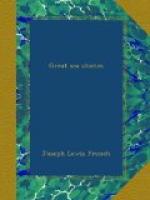But Gunderman was not drunk, nor were his boat party; and the court-martial he held on the beach in broken English and with the sack of coin beside him as chief witness would form a bright page of literature had one time to record it.
Ginnell, as owner of the Heart of Ireland, received the whole brunt of the storm; there was no hearing for him when, true to himself, he tried to cast the onus of the business on Blood and Harman. He was told to get out and be thankful he was not brought back to ’Frisco in irons, and he obeyed instructions, rowing off to the schooner, he and Harman and Blood, a melancholy party with the exception of Blood, who was talking to Harman with extreme animation on the subject of beam engines.
On deck it was Blood who gave orders for hauling up the anchor and setting sail. He had recaptured the revolver.
THE DERELICT NEPTUNE*
From “Spun Gold,” BY MORGAN ROBERTSON
Reprinted by courtesy of Harper & Brothers.
Across the Atlantic Ocean from the Gulf of Guinea to Cape St. Roque moves a great body of water—the Main Equatorial Current—which can be considered the motive power, or mainspring, of the whole Atlantic current system, as it obtains its motion directly from the ever-acting push of the tradewinds. At Cape St. Roque this broad current splits into two parts, one turning north, the other south. The northern part contracts, increases its speed, and, passing up the northern coast of South America as the Guiana Current, enters through the Caribbean Sea into the Gulf of Mexico, where it circles around to the northward; then, colored a deep blue from the fine river silt of the Mississippi, and heated from its long surface exposure under a tropical sun to an average temperature of eighty degrees, it emerges into the Florida Channel as the Gulf Stream.
From here it travels northeast, following the trend of the coast line, until, off Cape Hatteras, it splits into three divisions, one of which, the westernmost, keeps on to lose its warmth and life in Baffin’s Bay. Another impinges on the Hebrides, and is no more recognizable as a current; and the third, the eastern and largest part of the divided stream, makes a wide sweep to the east and south, enclosing the Azores and the deadwater called the Sargasso Sea, then, as the African Current, runs down the coast until, just below the Canary Isles, it merges into the Lesser Equatorial Current, which, parallel to the parent stream, and separated from it by a narrow band of backwater, travels west and filters through the West Indies, making puzzling combinations with the tides, and finally bearing so heavily on the young Gulf Stream as to give to it the sharp turn to the northward through the Florida Channel.




